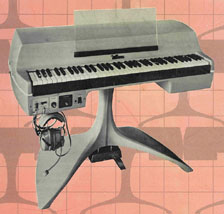Student Pianos
Harold Rhodes had music education in mind when he developed his first pianos, and this fervent interest continued when the first professional Rhodes models were introduced in the mid-1960's. The Fender Rhodes KBS 7024 Keyboard Instruction System was a student version of the 73-key piano with a space age design, featuring a contoured fiberglass body. The concept behind these pianos was to have a classroom full of them, with the teacher operating an instructor console that allowed him or her to "listen in" on individual students.
 |
 |
The first student pianos from 1965-66 were gold in color, with a single- or dual-pedestal base and a metronome/volume control box mounted on the underside. The amplifier for these pianos was actually a bench that the student would sit upon. In 1967, the design was improved to include the speaker on the underside of the piano itself. Colors for this second generation included a bright yellow (standard), as well as Avocado Green, Fiesta Red and Cinnamon Red. The base for these pianos had a "fishtail" design with a white pinstripe down the front of the pedestal, and the metronome was integrated with the piano body. A third generation was introduced in 1968, with a more contoured fishtail base (sans pinstripe) and Avocado Green as the primary color. The metronome component in these later models featured a "signal instructor" switch, a headphone amplifier and a microphone input used for communicating with the teacher. An instructor version of the piano was also available, with the only difference being the interface on the control unit.
 |
 |
 |
 |
 |
|
1960's Student Piano photos provided by Kenneth Manning |
||
In 1969, the Rhodes KMC I Keyboard Music Center replaced the "Jetsons" model, coinciding with the cosmetic transition from silver harp covers to black in the rest of the Fender Rhodes product line. The KMC I was essentially a one-piece Suitcase 73 with a scaled-down amp (15W with two 10" speakers) and no Vibrato effect. The control unit from this period had the same features as the KBS 7024. Interesting to note is that the KMC I was the first CBS piano marked with the "Rhodes" logo as we know it today.
 |
|
control unit photo provided by Kaz Iwase |
The new design was based on a walnut cabinet, making it suitable for use as a living room piano, while retaining the black plastic harp cover and "Seventy-Three" logo found on any other Mark I. A home version of the KMC I was also available, replacing the metronome unit with a headphone jack and a built-in cassette recorder. A second foot pedal was added for use as a volume control, similar to the swell pedal on a Hammond organ. In 1974 CBS discontinued the Rhodes educational program, but it is unclear as to whether the KMC I's continued to be sold to the consumer market during or after that time.
 |
